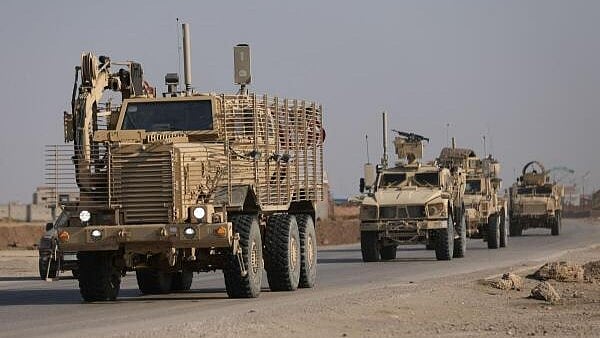
US military vehicles drive in Hasaka, Syria December 6, 2024.
Credit: Reuters Photo
In just over a week, Syrian rebel forces have seized much of Syria's northwest from the government in a fast-moving attack, upending the once-stagnant civil war. After capturing most of the major city of Aleppo, its airport, military bases and many towns and villages, they drove government troops from the western city of Hama on Thursday.
The offensive comes after a period of relative, if brittle, calm. Since 2020, the territorial map had stayed largely frozen: President Bashar Assad's government dominated much of the country, while an array of other factions held fragments of the rest. Here's who is fighting whom in Syria's nearly 14-year-old civil war.
Opposition forces: Their territory had shrunk until advances this week
The war erupted in 2011 after Assad brutally crushed anti-government protests. In the early stages, rebels -- who included both extremist Islamist and moderate factions -- managed to take most of the country's northwest and expanded into other territory. By 2014, they controlled not only their stronghold in the northwest, but also areas north of Hama, east of Damascus, the capital, and in the southeast, near the Israeli border, as well as villages along the Euphrates River and in al-Hasakah province, in Syria's far northeast.
Then came the rise of the Islamic State group in 2014 and Russia's decision the following year to give Assad military support. The Islamic State group expanded its so-called caliphate into northeastern Syria, while overpowering Russian airstrikes forced the original rebel groups to retreat. By this year, those opposition forces held nothing but a patch of the northwest until their latest offensive began last week.
Government forces and allies: The conflict had shifted in their favor years ago -- but now they are retreating
Despite initial rebel successes, pro-Assad forces -- including not only Syria's military but also fighters sent by Iran and the Iran-backed Lebanese militia Hezbollah -- were able to retake more territory over the past decade after a series of events shifted the conflict in their favor. Pro-government troops recaptured Aleppo with the help of Russian airstrikes after a four-year battle ending in 2016.
The next year, a government offensive against the Islamic State group put Assad back in control of many towns along the Euphrates River. And his forces' advance on northwestern Syria in 2019 and 2020 cornered opposition forces in Idlib province, bringing the conflict to an impasse that lasted until a week ago.
Islamic State group: It once held a third of Syria
Syria's civil war, along with growing instability in Iraq, allowed an ambitious al-Qaida offshoot called the Islamic State group to mushroom rapidly across both countries in 2013 and 2014. Fueled by a bloody, ultraextremist interpretation of Islam, it conquered an expanse of territory in Syria and Iraq that it ruled as a so-called caliphate. At its height in 2015, the group held a third of Syria and about 40 per cent of Iraq, with the northern Syrian city of Raqqa as its capital.
But a Western coalition led by the United States targeted the group with thousands of airstrikes, and US-backed Kurdish-led forces eventually routed the Islamic State group in much of northeastern Syria. Pro-Assad forces also pushed the group back in other areas, while the Iraqi army battled it in Iraq. By 2018, it had lost all but tiny shreds of its territory.
Kurdish-led forces: They took territory from the Islamic State group, but lost other ground to Turkish-backed forces
Forces from Syria's Kurdish ethnic minority became the United States' main local partner in the fight against the Islamic State group. After the extremist group was defeated in large parts of the country, Kurdish-led forces consolidated control over towns in the northeast, expanding an autonomous region they had built there, and along the Euphrates. But despite routing the Islamic State group, Kurdish fighters still had to contend with their longtime enemy across the border, Turkey, which regards them as linked to a Kurdish separatist insurgency.
In 2019, President Donald Trump pulled US troops away from northern Syria, abandoning Kurdish-led forces and opening the door for Turkish forces to oust them from areas along the northern border. Looking for protection against Turkey, Kurdish-led forces turned to Damascus, allowing Assad's forces to return to parts of northern Syria, where they have coexisted since. The Kurds still control much of northeastern Syria.
Turkish military operations: They captured parts of the northern border area from Kurdish-led forces
Since the beginning of the civil war, the Turkish military has launched several military interventions across the border into Syria, mostly against Syrian Kurdish-led forces, whom Turkey views as linked to what it calls a terrorist separatist movement in Turkey, the Kurdistan Workers' Party. Three Turkish operations -- in 2016-17, 2018 and 2019 -- were aimed at taking control of towns and villages the Kurdish-led fighters had previously held along the northern border. Turkey now effectively controls that zone, where it provides public services and where its currency is routinely used.